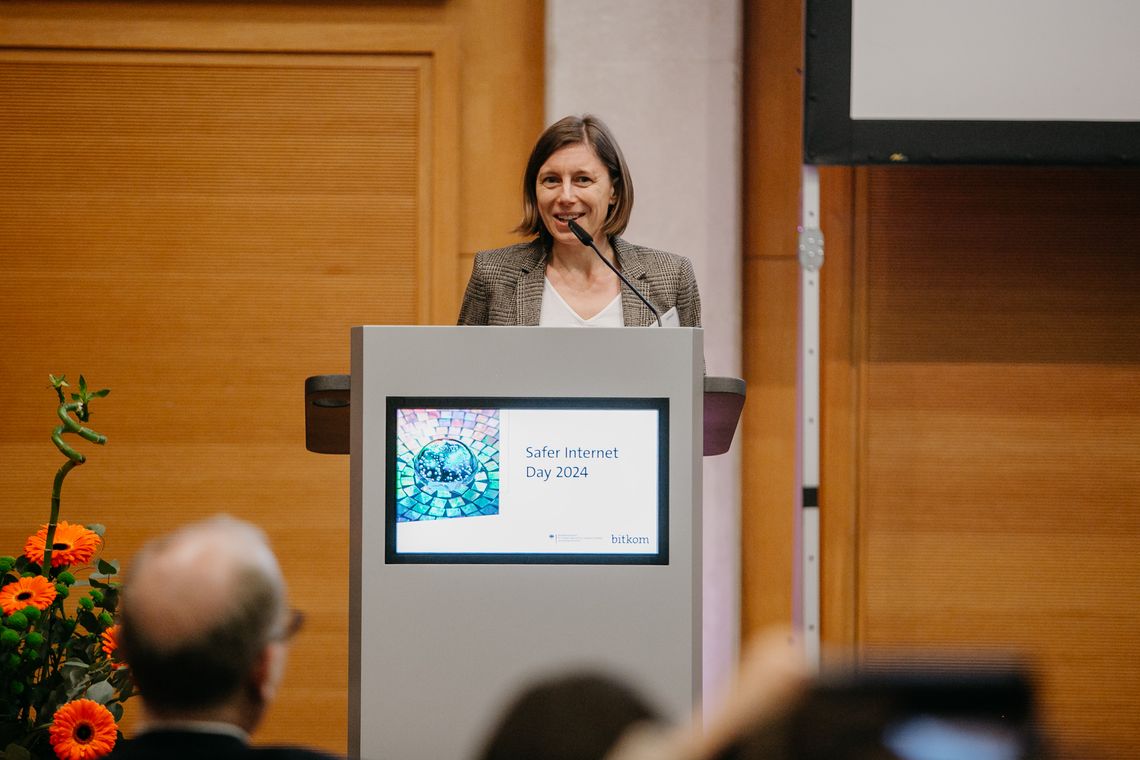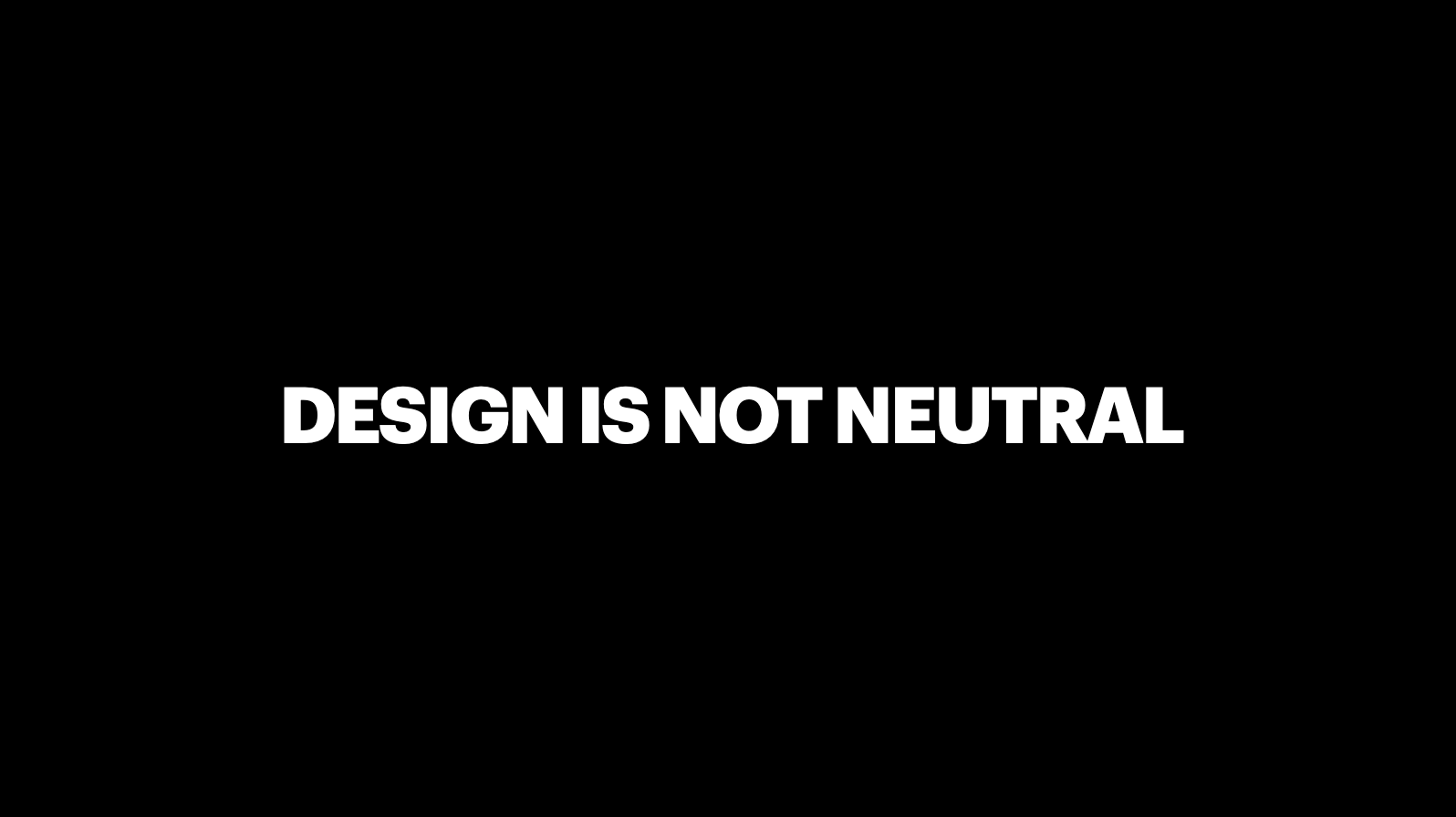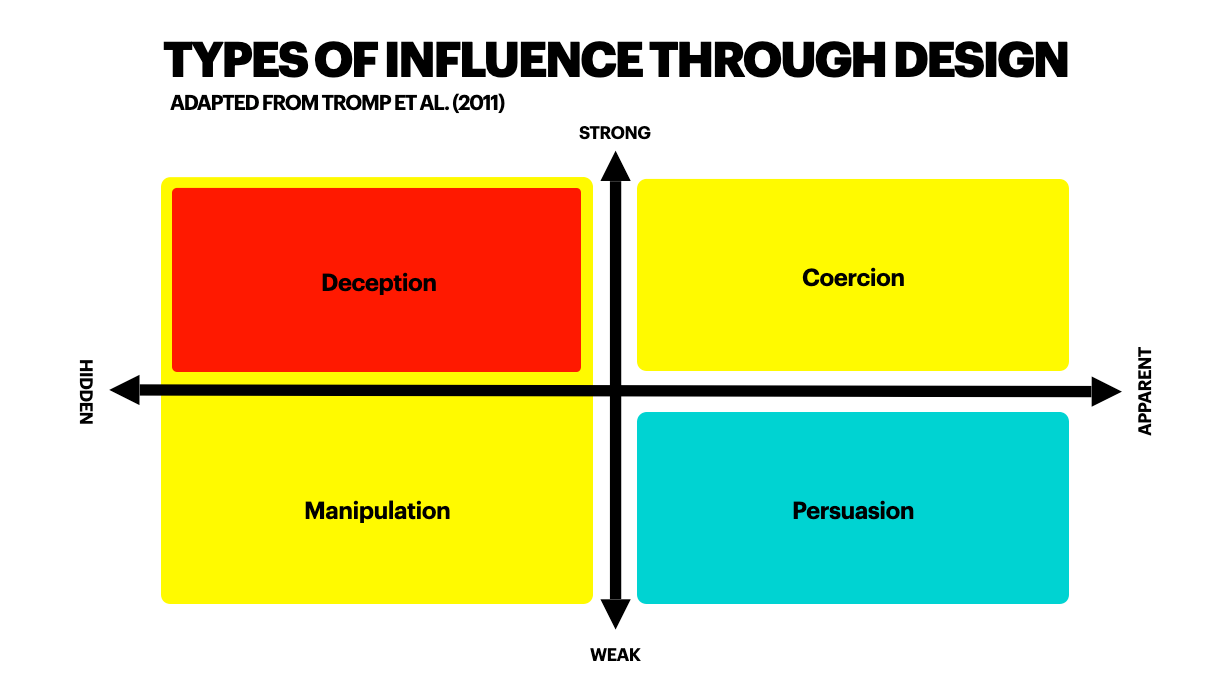Fair by Design

Before joining the LMDDC and the mission of upskilling citizens in and around Luxembourg, I researched the effect of deceptive digital designs on user behaviour. These so-called dark patterns englobe "user interface design choices that benefit an online service by coercing, steering, or deceiving users into making decisions that, if fully informed and capable of selecting alternatives, they might not make" (Mathur et al., 2019). They influence behaviour through obstruction, sneaking or interface interference (Gray et al., 2023). Even if you are unfamiliar with the term, you have likely faced them already. In Europe, you see them as soon as you visit a new webpage and encounter a cookie banner that makes it effortless to consent to data tracking and challenging to decline it. You can find ample information on the subject on a dedicated website. And if you have some proficiency in German, you can discover various dark patterns through a cookie refusal game: "who agrees, loses".
The UX community opposes the dark pattern practice, and a European directive demands "fairness by design". However, this poses a challenge for professionals who wonder: What constitutes fair design? The German Bitkom e.V. reached out to us with this question. They invited us to give a lightning talk during the Safer Internet Day 2024, co-organised with the German Federal Ministry for the Environment, Nature Conservation, Nuclear Safety and Consumer Protection (BMUV). In this article, we will outline the main points of our talk.

Design is not neutral.
Firstly, let us acknowledge that design is not neutral. Design always pursues a goal regarding user behaviour. There are various strategies for influencing users. Influence can range from weak to strong and it can be hidden or apparent, resulting in varying degrees of fairness. The diagram underneath depicts these two axes and positions the different types of influence.

Within this diagram, manipulation exerts a hidden influence, deception distorts or conceals relevant information, and coercion is apparent but leaves the user with no alternative (Sánchez Chamorro et al., 2023). To simplify, anything falling under manipulation, deception, or coercion is likely unfair. When it comes to weak and apparent persuasion, fairness depends on the context, user groups, and values. From user studies (Bongard-Blanchy et al., 2021), we know that recognising even weak, apparent strategies does not necessarily mean people can easily resist their influence. So the question becomes, where do we establish the boundary between fair and unfair persuasion? Let us explore three different approaches to address this question.
Intentions and potential harm
Two key considerations are usually considered when evaluating dark pattern designs: the design intention and the potential for harm. These two can also serve to assess fairness.
Scholars define unfair influence as the deliberate effort to steer a person's behaviour toward objectives that the individual did not intend to pursue or that are not in their best interest (Moser et al., 2019; Rossi et Bongard-Blanchy, 2021; Skirpan et al., 2018; Spencer, 2020). Nonetheless, there is considerable controversy surrounding whether nudging users toward beneficial behaviour for themselves or society is fair (Thaler et Sunstein, 2021) - consider speed limits, for instance. This type of influence falls into the paternalism category and contradicts the self-determined user principle. Regardless of one's position, for fairness, any service should strive to align its objectives with those of its users.
Additionally, consumer protection evaluates the potential for a design to cause economic, physical, or psychological harm to specific users. This also encompasses privacy and attention loss, as the dark pattern tipline webpage illustrates. While these harms may not affect a large audience, it is crucial to account for various vulnerabilities that can impact individuals' best interests in certain situations. For fairness, all services should avoid exploiting vulnerabilities and mitigate potential harm.
Five Fair Design Heuristics
In a study conducted by Sánchez Chamorro et al. (2023), designers were tasked with developing solutions for two ethically complex scenarios. Their ensuing discussions about tactics for influencing user behaviour and the rationale behind them were analysed. The study findings unveiled specific strategies designers employ to exert a more or less subtle influence on users. Five Fair Design strategies were derived from these to delineate fair from unfair influence. Formulated as heuristics, they serve to assess the fairness of design solutions.
1. SUPPORT USER GOALS. Influencing user behaviour does not make a design manipulative per se. Nevertheless, evaluating whether the design objectives benefit the user equally or even more than the service is essential. Do our design objectives coincide with the user's immediate goals? Do they coincide with the user's future goals?

2. KEEP INCENTIVES RESISTIBLE. Incentives should be resistible, especially when targeting vulnerable populations. Thoroughly research the vulnerabilities of the target audience and evaluate whether the incentives would be challenging for them to resist. Avoid proposing irresistible incentives that exploit vulnerabilities.

3. BE CAREFUL WITH EMOTIONS. Exercise caution when using emotions in design. Design should avoid excessive emotional appeal through language, visuals, and sound. Assess if these appeals are difficult for specific user groups to resist and avoid or tone them down if necessary.

4. USE FRICTION FOR GOOD. Friction means integrating obstacles into the navigation flow. It can encourage reflection and prevent hasty actions like deleting data. When the design introduces friction, consider its alignment with user needs and usability. However, do not hinder users from reaching their goal even if that would be in the service interest (e.g., cancelling a subscription).

5. PROVIDE FAIR DECISION SPACES. Users should have fair decision-making opportunities. Their autonomy relies on well-informed choices, so all options must be presented impartially for objective selections. The information given should be accurate, essential, and free from excessive and irrelevant details. Emphasising choices should not lead users away from their best interests.

Certainly, conducting a heuristic evaluation demands considerable time and expertise. Regrettably, such time is often scarce in daily business operations. Therefore, it may be helpful to incorporate the following series of quick questions into your fair design practice.
Four Ethical Design Questions

In his book "Future Ethics," Chennydd Bowles presents four questions design professionals should consider to uphold ethical standards in their solutions. Look at your design solution and ask:
What if everyone did what I'm about to do? Would a world in which this was a universal law of behaviour be a better place or a worse place?
Am I treating people as ends or as means? Am I treating users as free individuals with their own goals that are as important or potentially even more important than my own? Or am I seeing them as ways for me to hit my own targets?
Am I maximising happiness for the greatest number of people? And by extension, am I minimising suffering for as many people as I can?
Would I be happy for this to be a front-page story?
(quoted from the transcript of the 2019 talk Future Ethics with Cennydd Bowles at SustainableUX)
Some Good Examples
Finally, exploring sources of inspiration for practical examples may also be beneficial. Some online collections already showcase fair design patterns that can serve as a reference for creating fairer decision-influencing designs.
https://design.cnil.fr/en/design-patterns/
https://privacypatterns.org/patterns/
https://fairpatterns.com/what-are-dark-patterns/
https://catalogue.projectsbyif.com/
However, it is crucial to keep in mind that each problem necessitates its own solution. While an ideal and fair solution may resemble one of the good examples at times, in a specific situation, a fair example can also transform into an unfair design. Be inspired by good practices, but don't just use them as a blueprint.
Commitment To Fair Design
If you have read this far, we thank you for your interest and your commitment to fair design. Although it may seem uncommon in our EdTech communications, this subject is relevant to the LMDDC's mission as it presents an educational challenge - how can we raise awareness among the general public and professionals about deceptive/fair design practices? Additionally, as creators of interactive experiences, we must ensure fairness in the solutions we devise with our partners for the public.
References
Bongard-Blanchy, K., Rossi, A., Rivas, S., Doublet, S., Koenig, V., & Lenzini, G. (2021, June). "I am Definitely Manipulated, Even When I am Aware of it. It's Ridiculous!" - Dark Patterns from the End-User Perspective. In Designing Interactive Systems Conference 2021 (pp. 763-776). https://doi.org/10.1145/3461778.3462086
Bowles, C. (2018). Future ethics. NowNext Press.
Gray, C. M., Santos, C., Bielova, N., & Mildner, T. (2023). An Ontology of Dark Patterns Knowledge: Foundations, Definitions, and a Pathway for Shared Knowledge-Building. arXiv preprint arXiv:2309.09640. https://arxiv.org/pdf/2309.09640.pdf
Mathur, A., Acar, G., Friedman, M. J., Lucherini, E., Mayer, J., Chetty, M., & Narayanan, A. (2019). Dark patterns at scale: Findings from a crawl of 11K shopping websites. Proceedings of the ACM on Human-Computer Interaction, 3(CSCW), 1-32. https://doi.org/10.1145/3359183
Moser, C., Schoenebeck, S. Y., & Resnick, P. (2019, May). Impulse buying: Design practices and consumer needs. In Proceedings of the 2019 CHI Conference on Human Factors in Computing Systems (pp. 1-15). https://doi.org/10.1145/3290605.3300472
Rossi, A., & Bongard-Blanchy, K. (2021). All in one stroke? Intervention Spaces for Dark Patterns. arXiv preprint arXiv:2103.08483. https://arxiv.org/pdf/2103.08483.pdf
Sánchez Chamorro, L., Bongard-Blanchy, K., & Koenig, V. (2023, July). Ethical Tensions in UX Design Practice: Exploring the Fine Line Between Persuasion and Manipulation in Online Interfaces. In Proceedings of the 2023 ACM Designing Interactive Systems Conference (pp. 2408-2422). https://doi.org/10.1145/3563657.3596013
Skirpan, M., Beard, N., Bhaduri, S., Fiesler, C., & Yeh, T. (2018, February). Ethics education in context: A case study of novel ethics activities for the CS classroom. In Proceedings of the 49th ACM Technical Symposium on Computer Science Education (pp. 940-945). https://doi.org/10.1145/3159450.3159573
Spencer, S. B. (2020). The problem of online manipulation. U. Ill. L. Rev., 959. Chicago. https://www.illinoislawreview.org/wp-content/uploads/2020/06/Spencer.pdf
Thaler, R. H., & Sunstein, C. R. (2021). Nudge: The final edition. Yale University Press.
Tromp, N., Hekkert, P., & Verbeek, P. P. (2011). Design for socially responsible behavior: a classification of influence based on intended user experience. Design issues, 27(3), 3-19.


